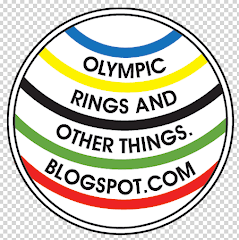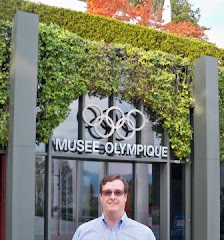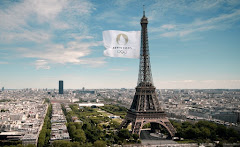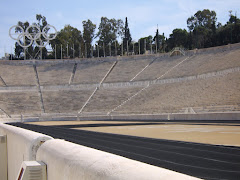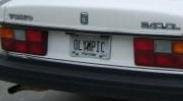When a banner for the exhibition recently went up locally, lyrics to Debbie Harry's seldom-heard passionate smooching song played in my head and inspired the rhyming headline to this post.
In anticipation of the recent exhibition media preview, I dusted off memories of my first Rodin encounters, both in 1996, also at the High.
Visiting the museum a week after moving to Georgia, the artist's solemn work "The Shade" -- the centerpiece of a memorial to 106 Atlantans lost in the Orly air disaster of 60 years ago -- greeted me on the approach to Richard Meier's award-winning building on Peachtree Street.Later that year, of course, the exhibition "Rings: Five Passions in World Art" (photo below) was a cornerstone of the Cultural Olympiad in which Rodin's six-foot marble masterpiece "The Kiss" was a showstopping loan from the Rodin Museum in Paris.
The new exhibition also features "The Kiss" though this time in bronze borrowed from the Baltimore Museum of Art, where I previously enjoyed this version during a New Jersey to Georgia road trip pit stop of summer 2018 (yes, I brake/break for museums).Here are five other Rodin works that caught my eye now on view at the High:
The marble "Christ and Mary Magdalene" -- for which Rodin supervised carving rather than himself chiseling, according to the exhibition wall text -- bookends silky smooth lines of the Biblical characters with rough, unfinished stone pockmarked by somewhat symmetrical knife-poked divots. Taking inspiration from the themes of Slow Art Day, I spent nearly 10 quiet minutes studying this work from all sides and it is extraordinary. This work is loaned by another Meier-designed masterpiece museum, The Getty in Los Angeles.
"Female Torso with a Slavic Woman's Head" (photo below), which I vaguely recalled from an early 2000s Rodin exhibition at its Legion of Honor home in San Francisco, is an armless plaster figure whose downward gaze perhaps inspired Quintin Tarantino's French-Japanese character Sophie Fatale. As some may recall, she was the interpreter rolled down the snowy hill to a Tokyo emergency room in "Kill Bill: Vol. 1." But what woman will you see and be inspired to revisit via Rodin's work?
Speaking of Japan, for the drawing "Hanako" Rodin sketched his only Japanese model, a touring actress named Hisa Ota (or is it Ota Hisa?). I loved viewing the pen and ink later colored with crayon. While writing this post, a more detailed back story of the actress' intro to Rodin came to light via this site and their eventual artist:spouse:model collaboration is fascinating.According to wall texts, "The Prodigal Son" bronze (photo below) was cast for the 1915 Panama-Pacific Exposition in San Francisco. This was another Legion of Honor work seen previously and it proved as moving now as ever.
If this exhibition's iconic showpiece is "The Thinker" then its feminine counterpart conversation starter may be "Iris, Messenger of the Gods" on holiday from the Smithsonian/Hirshhorn Museum in D.C. Rodin left little to the imagination rendering the bronze "unexhibitable" for prudish American museums. The model was definitely more provocateur less demure.


























